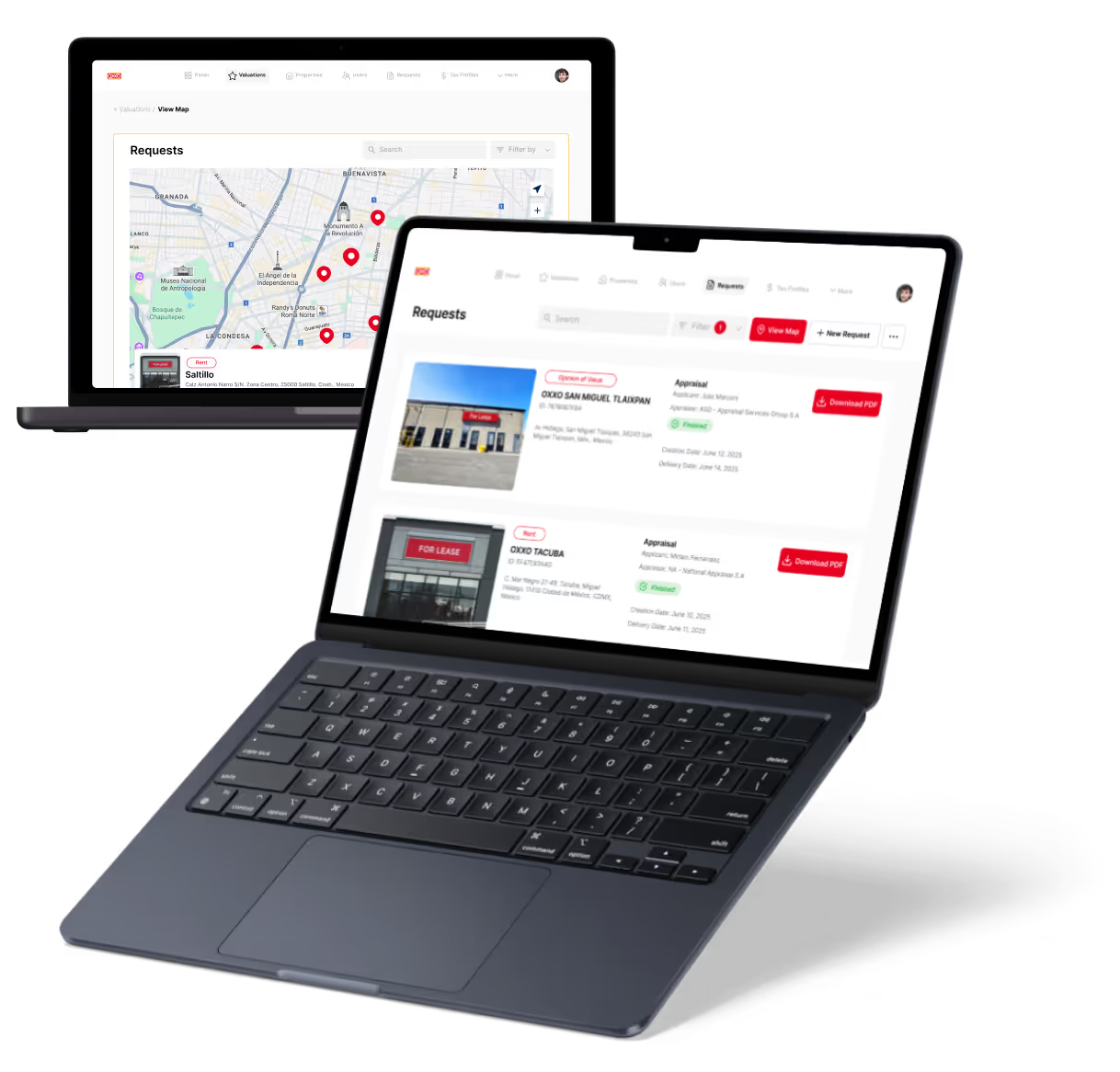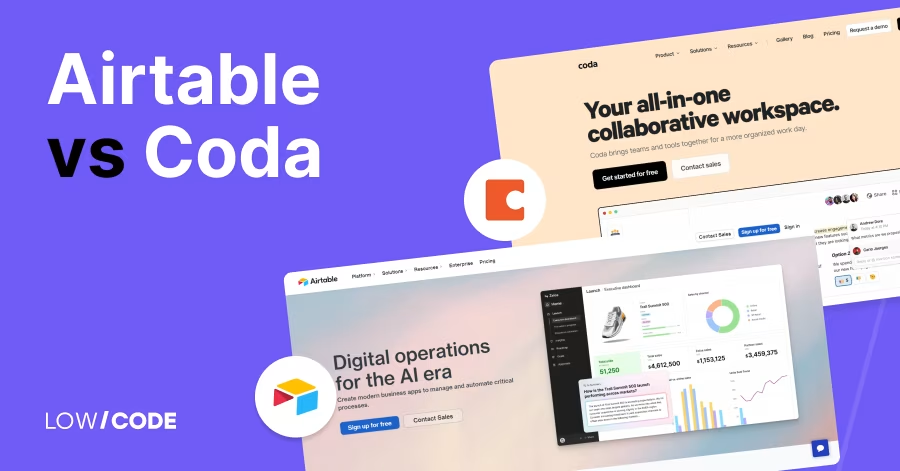Appsheet vs Power Apps | 9 Factors to Decide the Best One
12 min
read
Compare AppSheet vs Power Apps on 9 key factors like ease of use, pricing, integration, and customization to find the best no-code platform for you

When you're choosing between no-code platforms for business app development, understanding each platform's foundation helps you make informed decisions. Both AppSheet and Power Apps have evolved from different tech giants with distinct approaches to solving business automation challenges.
Let's explore what each platform brings to the table and how their origins shape their capabilities today.
What Is AppSheet?
AppSheet is Google's no-code platform that transforms your existing data sources into powerful mobile and web applications. Originally founded as an independent company in 2012, AppSheet was acquired by Google in 2020 and integrated into the Google Workspace ecosystem.
The platform excels at turning spreadsheets, databases, and cloud storage into functional business apps without requiring coding expertise. You can connect data from Google Sheets, Excel, SQL databases, and other sources to create apps that handle everything from inventory management to field service operations.
What sets AppSheet apart is its intelligent approach to app creation. The platform analyzes your data structure and automatically suggests app layouts, user interfaces, and workflows that match your business processes. This means you can often build a working prototype in minutes rather than hours.
Read more | FlutterFlow vs Appsheet
What Is Power Apps?
Power Apps is Microsoft's comprehensive low-code development platform designed to create custom business applications across the Microsoft ecosystem. Launched in 2016 as part of Microsoft's Power Platform suite, it integrates seamlessly with Office 365, SharePoint, Teams, and other Microsoft services.
The platform offers two primary development approaches: canvas apps for pixel-perfect custom interfaces and model-driven apps for data-centric business processes. You can build everything from simple data collection forms to complex workflow applications that connect multiple data sources and business systems.
Power Apps leverages Microsoft's enterprise-grade infrastructure and security standards, making it particularly attractive for organizations already invested in Microsoft technologies. The platform connects to hundreds of data sources and includes built-in AI capabilities through integration with Microsoft's Cognitive Services.
To move from evaluation to production quickly, many teams hire Powerapps developer support to design connectors, Dataverse models, and governance.
Target Audience and Use Cases
Choosing the right platform depends heavily on your organization's existing tech stack, team expertise, and specific business needs. Both AppSheet and Power Apps serve different audiences and excel in particular scenarios.
Understanding who benefits most from each platform will help you align your choice with your organization's goals and technical capabilities.
Who Should Use AppSheet?
AppSheet works exceptionally well for organizations and individuals who need rapid app development with minimal technical overhead. Here's who benefits most from this platform:
- Google Workspace users who already store data in Google Sheets, Drive, or other Google services and want seamless integration with their existing workflow.
- Small to medium businesses that need quick solutions for common business processes like inventory tracking, customer management, or field data collection.
- Non-technical teams including HR departments, operations managers, and field workers who understand their data but lack coding experience.
- Organizations with mobile-first requirements that need apps optimized for smartphones and tablets, especially for field work or remote data collection.
- Businesses seeking rapid prototyping to validate app concepts quickly before investing in more complex development solutions.
- Cost-conscious organizations looking for a straightforward pricing model without complex licensing structures or hidden fees.
- Teams managing simple data relationships where most business logic revolves around CRUD operations (Create, Read, Update, Delete) rather than complex workflows.
Read more | Bubble vs Appsheet
Who Should Use Power Apps?
Power Apps targets organizations that need enterprise-grade applications with sophisticated functionality and deep Microsoft integration. The ideal users include:
- Microsoft-centric organizations already using Office 365, SharePoint, Teams, or Dynamics 365 who want to leverage existing investments and user familiarity.
- Large enterprises requiring robust governance, compliance features, and enterprise-level security controls for their business applications.
- IT departments and citizen developers with some technical background who can handle more complex app logic and data modeling requirements.
- Businesses with complex workflows that need advanced business process automation, approval chains, and integration with multiple enterprise systems.
- Organizations requiring extensive customization where pixel-perfect UI design and complex user interactions are essential for business success.
- Companies needing advanced analytics that want to combine app functionality with Power BI dashboards and comprehensive reporting capabilities.
- Businesses with complex data relationships involving multiple entities, calculated fields, and sophisticated business rules that go beyond simple data entry.
- Organizations prioritizing scalability that expect significant user growth and need a platform capable of supporting thousands of concurrent users.
Ease of Use Comparison
The learning curve and user experience can make or break your no-code journey. While both platforms promise to democratize app development, they take different approaches to achieving this goal.
Your team's technical background and tolerance for complexity will largely determine which platform feels more intuitive and productive for your specific needs.
How Easy Is It to Build Apps on AppSheet?
AppSheet prioritizes simplicity and automation, making it one of the most approachable no-code platforms for complete beginners. The platform's intelligent design significantly reduces the manual work required to create functional apps:
- Getting started is remarkably straightforward: You simply connect your data source, and AppSheet automatically generates a working app based on your data structure. The platform analyzes your spreadsheet columns and creates appropriate input fields, views, and navigation without any manual configuration.
- The interface feels intuitive and uncluttered: AppSheet uses a clean, Google-inspired design with logical menu structures that don't overwhelm new users. Most configuration happens through simple dropdown menus and checkboxes rather than complex formula builders or code editors.
- Customization remains accessible to non-technical users: While you can add sophisticated features like workflows and business logic, the platform presents these options in plain English rather than technical jargon. You'll find options like "Send an email when..." instead of complex conditional statements.
- The mobile-first approach simplifies decision-making: Since AppSheet optimizes for mobile use by default, you spend less time worrying about responsive design and more time focusing on your app's functionality and user experience.
- Learning resources are abundant and practical: Google provides extensive documentation, video tutorials, and templates that help you understand concepts through real-world examples rather than abstract technical explanations.
How Easy Is It to Build Apps on Power Apps?
Power Apps offers tremendous flexibility and power, but this comes with increased complexity that requires more time and effort to master effectively.
- The initial setup involves more decision points: You need to choose between canvas apps and model-driven apps, understand different data source types, and navigate Microsoft's broader ecosystem of interconnected services before building your first application.
- The interface can feel overwhelming for newcomers: Power Apps Studio resembles traditional development environments with multiple panels, property settings, and formula bars that may intimidate users without technical backgrounds.
- Canvas apps require design skills and patience: Unlike AppSheet's automatic layouts, you'll need to manually position every button, text field, and image. This pixel-level control offers great flexibility but demands significant time investment for polished results.
- Formula syntax mirrors Excel but with added complexity: While existing Excel users might recognize some patterns, Power Apps formulas often require understanding of delegation, context variables, and other programming concepts that go beyond spreadsheet knowledge.
- Model-driven apps involve data modeling concepts: Creating effective model-driven applications requires understanding relationships, business process flows, and entity configurations that feel more like traditional database design than no-code development.
- Learning resources are comprehensive but technical: Microsoft provides extensive documentation and training materials, but much of the content assumes familiarity with business application concepts and Microsoft's terminology conventions.
- The payoff justifies the learning investment: Once you overcome the initial learning curve, Power Apps enables sophisticated applications with enterprise-grade features that would be difficult to achieve with simpler platforms.
Customization and Flexibility
The depth of customization available determines how well each platform adapts to your unique business requirements. While both platforms offer extensive customization options, they approach flexibility from different angles.
Your choice will depend on whether you prioritize quick customization with smart defaults or comprehensive control over every aspect of your application.
Customization Features in AppSheet
AppSheet provides streamlined customization that balances ease of use with powerful functionality. The platform's intelligent automation handles many customization decisions automatically while still offering granular control when needed.
- Automatic UI generation with smart overrides: AppSheet analyzes your data and creates appropriate input controls, but you can easily modify field types, add validation rules, and customize display formats through simple dropdown menus and configuration options.
- Flexible workflow automation without coding: The platform's workflow builder uses natural language conditions like "when a record is updated" or "if a value exceeds a threshold" to trigger actions such as sending emails, updating records, or calling external APIs.
- Custom expressions and formulas: You can create sophisticated business logic using AppSheet's formula language, which combines familiar spreadsheet functions with app-specific capabilities for data manipulation, calculations, and conditional formatting.
- Brand customization and theming: While not offering pixel-perfect control, AppSheet allows you to customize colors, logos, and basic styling to match your organization's brand identity without requiring design expertise.
- Dynamic user interfaces: The platform supports conditional visibility, dynamic filtering, and user role-based access controls that adapt your app's interface based on user permissions and data context.
- Integration capabilities: AppSheet connects with Google Workspace, external databases, REST APIs, and other business systems through pre-built connectors and custom webhook configurations.
- Limited but focused customization scope: While you can't control every visual detail, AppSheet's constraints actually accelerate development by providing professional-looking defaults that work well across devices and use cases.
Read more | Appsheet Alternatives
Customization Features in Power Apps
Power Apps delivers enterprise-level customization capabilities that enable pixel-perfect control and sophisticated business logic implementation. The platform treats customization as a core strength rather than an optional feature.
- Comprehensive visual design control: Canvas apps offer complete freedom over layout, positioning, colors, fonts, and animations. You can create custom components, implement complex navigation patterns, and design interfaces that match exact specifications.
- Advanced formula and expression system: Power Apps uses a robust formula language that supports complex calculations, data transformations, conditional logic, and integration with Azure Functions for serverless computing capabilities.
- Sophisticated data modeling: Model-driven apps enable you to define custom entities, relationships, business rules, and calculated fields that create database-like functionality with enterprise governance features.
- Custom connectors and API integration: The platform supports hundreds of pre-built connectors and allows you to create custom connectors for proprietary systems, legacy applications, and specialized business services.
- Role-based security and permissions: Power Apps implements granular security controls that can restrict access to specific screens, data fields, and functionality based on user roles and organizational hierarchies.
- Business process automation: Integration with Power Automate enables sophisticated workflow automation that can span multiple applications, trigger based on complex conditions, and integrate with external systems.
- Component libraries and reusability: You can create custom components, maintain shared libraries, and implement design systems that ensure consistency across multiple applications within your organization.
- Advanced customization requires expertise: While the customization capabilities are extensive, implementing complex features often requires understanding of programming concepts, data relationships, and Microsoft's platform architecture.
Integration Capabilities
Integration capabilities determine how well each platform fits into your existing technology ecosystem. Both AppSheet and Power Apps excel at connecting with their parent companies' services, but they also offer different approaches to third-party integrations.
The strength of these integrations often influences the total cost of ownership and determines how seamlessly your new apps will work with your current business processes.
AppSheet Integrations
AppSheet's integration strategy centers around Google's ecosystem while maintaining flexibility for organizations using mixed technology stacks. The platform's native Google Workspace integration provides seamless data synchronization and user authentication that eliminates many common integration headaches.
Google Sheets integration represents AppSheet's strongest capability, offering real-time bidirectional sync that treats your spreadsheet as a live database. Changes made in your app instantly appear in the corresponding Google Sheet, while updates to the spreadsheet automatically reflect in your application.
The platform extends beyond Google Workspace to support Microsoft Excel files, SQL databases including MySQL and PostgreSQL, and cloud storage services like Dropbox and OneDrive. AppSheet's API capabilities enable connections to external services through REST APIs and webhooks, allowing integration with CRM systems and custom business applications.
Email integration leverages Gmail's infrastructure for automated notifications, while SMS messaging support enables mobile communication capabilities that extend your app's reach beyond traditional interfaces.
Read more | Airtable vs Appsheet
Power Apps Integrations
Power Apps leverages Microsoft's comprehensive business ecosystem to deliver enterprise-grade integrations that span productivity tools, cloud services, and business applications. The platform's integration philosophy focuses on creating unified experiences across the entire Microsoft technology stack.
Microsoft 365 integration creates seamless workflows between your custom apps and familiar productivity tools. SharePoint serves as a powerful data source, Teams integration allows embedding apps directly into channels, and Outlook integration enables interaction with email and calendar data while maintaining security controls.
Azure services integration transforms Power Apps into a gateway for cloud-native capabilities. Azure SQL Database provides enterprise-scale data storage, while Azure Active Directory ensures consistent authentication across your technology landscape. Connection to Azure Functions enables serverless computing for complex business logic.
The platform's connector ecosystem includes over 400 pre-built connectors for popular business applications including Salesforce, SAP, and ServiceNow. Power Automate integration creates sophisticated workflow automation, while Dynamics 365 integration enables custom functionality extensions for Microsoft's business applications.
Offline Functionality
Offline functionality becomes critical when your team works in areas with unreliable internet connectivity or needs to access data while traveling. Both platforms handle offline scenarios differently, with varying degrees of capability and data synchronization approaches.
Understanding these offline limitations helps you choose the right platform for field work, remote operations, and situations where consistent internet access isn't guaranteed.
Offline Support in AppSheet
AppSheet provides robust offline functionality that's particularly well-suited for mobile fieldwork and data collection scenarios. The platform automatically downloads app data to devices when connected, allowing users to view, edit, and create records without an internet connection.
When users work offline, AppSheet stores all changes locally and automatically syncs updates when connectivity returns. The platform handles conflict resolution intelligently while maintaining full app functionality including form validation and calculated fields.
This approach works exceptionally well for field teams conducting inspections or updating customer information in remote locations.
Offline Support in Power Apps
Power Apps offers limited offline functionality that varies significantly between canvas and model-driven apps. Canvas apps support basic offline scenarios through SaveData and LoadData functions, but this requires manual implementation and doesn't provide a seamless experience.
The platform's offline capabilities work best for simple data collection forms without connectivity. However, complex business logic and external data connections typically require an active internet connection to function properly. Organizations requiring extensive offline work should carefully evaluate whether Power Apps meets their specific field operation needs.
Deployment and Accessibility
Deployment methods and user access patterns significantly impact how quickly your team can start using new applications and how easily you can manage ongoing updates. Both platforms offer different approaches to getting apps into users' hands.
The deployment strategy you choose affects user adoption, security controls, and your ability to maintain applications as business requirements evolve over time.
How AppSheet Deploys Apps
AppSheet simplifies deployment through cloud-based distribution that eliminates traditional app store submissions and complex installation procedures. Users can access apps immediately through web browsers or by installing the AppSheet mobile app from app stores.
The platform generates unique URLs for each application that work across all devices. Users simply visit the provided link or scan a QR code to access your app instantly. Updates deploy automatically to all users without requiring individual app updates or reinstallation, while Google accounts control access to ensure only authorized team members can view your business data.
How Power Apps Deploys Apps
Power Apps provides multiple deployment pathways that integrate with Microsoft's enterprise ecosystem. Canvas apps deploy through the Power Apps portal where users access applications via web browsers or the Power Apps mobile app.
The platform leverages Microsoft 365 licensing and Azure Active Directory for authentication, with apps appearing in users' Power Apps launcher alongside other business applications. Model-driven apps can integrate into Dynamics 365 environments or deploy as standalone applications. Power Apps also supports controlled deployment through environment management, allowing IT administrators to stage applications through development, testing, and production environments.
Common Limitations of AppSheet and Power Apps
Every no-code platform comes with inherent limitations that may impact your project's success. Understanding these constraints upfront helps you set realistic expectations and choose the platform that best aligns with your specific requirements.
These limitations often become apparent only after you've invested significant time in development, making it crucial to evaluate them during your initial platform selection process.
Limitations of AppSheet
AppSheet's focus on simplicity and automation creates several constraints that may limit complex application development. The platform works exceptionally well for straightforward data management scenarios but struggles with sophisticated business logic and custom user experiences.
- Limited UI customization options restrict your ability to create pixel-perfect designs or implement complex navigation patterns. While AppSheet automatically generates professional-looking interfaces, you can't achieve the same level of visual control available in other platforms.
- Performance challenges emerge with large datasets as the platform wasn't designed for high-volume data processing. Apps may experience slower loading times when working with thousands of records or complex data relationships that require extensive calculations.
- Workflow automation capabilities remain basic compared to dedicated business process management tools. While you can create useful automations, complex approval chains or multi-step business processes often require workarounds or integration with external workflow platforms.
- Dependency on Google's ecosystem can create challenges for organizations heavily invested in Microsoft or other technology stacks. While AppSheet supports external data sources, the best user experience requires Google Workspace integration.
- Limited offline functionality for complex apps means that sophisticated business logic may not work properly without internet connectivity, potentially limiting field use in areas with poor network coverage.
Limitations of Power Apps
Power Apps offers extensive capabilities but comes with complexity and integration challenges that can overwhelm smaller organizations or non-technical users. The platform's enterprise focus creates barriers for simpler use cases.
- Steep learning curve and complexity make Power Apps challenging for citizen developers without technical backgrounds. Creating polished applications often requires understanding of programming concepts, data modeling, and Microsoft's platform architecture.
- Licensing costs can escalate quickly as user adoption grows, particularly when apps require premium connectors or advanced features. The pricing model may become prohibitive for larger user bases or organizations with budget constraints.
- Performance limitations with delegation create challenges when working with large datasets through certain connectors. Apps may experience slow performance or functionality restrictions when dealing with external data sources that don't support delegation.
- Heavy dependency on Microsoft ecosystem means that organizations using competing platforms may face integration challenges or miss out on key functionality that requires Microsoft 365 or Azure services.
- Version control and collaboration challenges can complicate team development scenarios, as Power Apps doesn't provide robust source control capabilities that development teams expect for managing complex applications over time.
- Mobile experience inconsistencies between different app types and devices can create user experience problems, particularly when trying to maintain functionality across web and mobile platforms simultaneously.
When to Choose Each Platform
Selecting between AppSheet and Power Apps requires careful consideration of your organization's technical capabilities, existing infrastructure, and long-term goals. The right choice depends on finding the platform that aligns with your team's skills and business requirements.
Making an informed decision now prevents costly migrations later and ensures your investment delivers maximum value for your specific use case and organizational context.
When AppSheet Is the Best Choice
AppSheet emerges as the ideal solution when your organization prioritizes rapid development and ease of use over extensive customization capabilities. The platform excels in scenarios where you need to quickly transform existing spreadsheet data into functional mobile applications without requiring significant technical expertise from your team.
Choose AppSheet if your organization already relies heavily on Google Workspace and you want seamless integration with existing workflows. The platform works exceptionally well for small to medium businesses that need practical solutions for inventory tracking, customer management, or field data collection with mobile workers who require offline functionality.
AppSheet suits organizations with straightforward data relationships and business processes that don't require complex workflows. When budget predictability matters and you prefer transparent pricing without complex licensing structures, AppSheet's straightforward cost model provides clear value for non-technical teams.
When Power Apps Is the Best Choice
Power Apps becomes the superior choice when your organization needs enterprise-grade applications with sophisticated functionality and deep integration across Microsoft's business ecosystem. The platform justifies its complexity when you require pixel-perfect user interfaces, complex business logic, or applications that must scale to support thousands of users.
Select Power Apps if your organization has invested heavily in Microsoft 365, SharePoint, or Dynamics 365 and you want to leverage these existing investments. The platform excels when you have citizen developers or IT professionals who can navigate complexity to create sophisticated applications with advanced workflows and approval chains.
Power Apps suits organizations that need extensive customization options, advanced analytics capabilities, or want to build multiple interconnected business applications with shared components and design systems across the Microsoft technology stack.
Created on
November 5, 2023
. Last updated on
November 21, 2025
.

FAQs
What are the main differences between AppSheet and Power Apps?
Which platform is easier for beginners to use?
How do AppSheet and Power Apps compare in pricing?
Can both platforms work offline?
Which platform integrates better with Microsoft or Google services?
When should I choose Power Apps over AppSheet?







%20(Custom).avif)







.avif)
